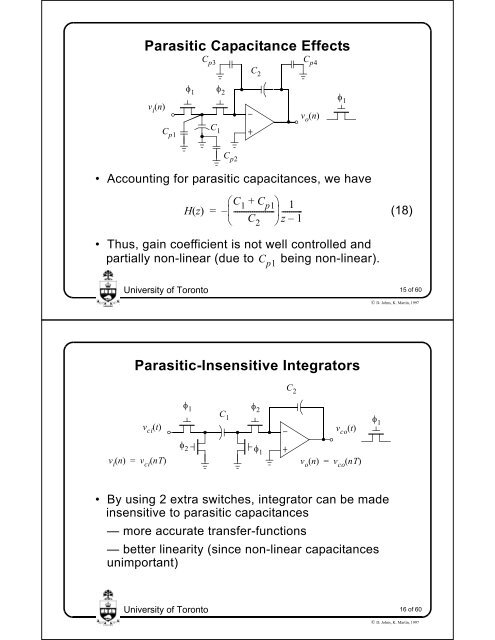Switched-Capacitor Circuits - University of Toronto
Switched-Capacitor Circuits - University of Toronto
Switched-Capacitor Circuits - University of Toronto
Create successful ePaper yourself
Turn your PDF publications into a flip-book with our unique Google optimized e-Paper software.
Parasitic Capacitance Effects<br />
vi() n<br />
C p1<br />
1<br />
C p3<br />
• Accounting for parasitic capacitances, we have<br />
Hz ()<br />
• Thus, gain coefficient is not well controlled and<br />
partially non-linear (due to being non-linear).<br />
<strong>University</strong> <strong>of</strong> <strong>Toronto</strong><br />
<strong>University</strong> <strong>of</strong> <strong>Toronto</strong><br />
C 1<br />
=<br />
2<br />
C p2<br />
C 2<br />
C1+ Cp1 1<br />
– --------------------- ----------<br />
z–<br />
1<br />
C 2<br />
C p1<br />
C p4<br />
vo( n)<br />
Parasitic-Insensitive Integrators<br />
vci() t<br />
vi( n)<br />
= vci( nT)<br />
1<br />
C 1<br />
• By using 2 extra switches, integrator can be made<br />
insensitive to parasitic capacitances<br />
— more accurate transfer-functions<br />
— better linearity (since non-linear capacitances<br />
unimportant)<br />
2<br />
2 1<br />
C 2<br />
1<br />
vco() t<br />
vo() n = vco( nT)<br />
(18)<br />
15 <strong>of</strong> 60<br />
© D. Johns, K. Martin, 1997<br />
1<br />
16 <strong>of</strong> 60<br />
© D. Johns, K. Martin, 1997














